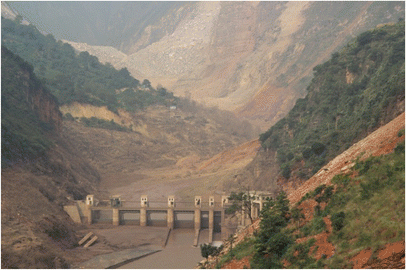5 October 2015
The seismically triggered landslide dam in Honshiyan, Yunnan, China: a review of a new paper
Posted by Dave Petley
The Honshiyan landslide dam in Yunnan, China
On 3rd August 2014 a Ms=6.5 earthquake in Ludian County, Yunnan Province in China triggered a large landslide at Honshiyan, about 1.5 km downstream of an existing hydroelectric power station. This landslide blocked the Niulanjiang River, requiring emergency actions to drain the lake impounded behind the dam. In a new paper just published online in the journal Landslides, Zhang et al. (2015) examine both the emergency actions needed to mitigate the immediate threat and the potential for the use of the dam for hydroelectric power generation.
The emergency response to the Honshiyan landslide dam
Zhang et al. (2015) describe the parameters of the blockage – it had a volume of 12 million cubic metres, was 92 metres high, 753 metres wide and 283 metres long. However, the blockage was rather complex as it was formed from two different collapse events from each side of the valley, as shown in the images below from the paper:

Panoramic view of the Hongshiyan landslide dam. This photo was taken upstream of the landslide dam (Zhang et al. 2015)
.
Analysis of the structure of the deposit suggested that it had a relatively high proportion of fine-grained particles as well as large boulders. Using a variety of analysis methods, Zhang et al. (2015) concluded that:
Based on the parameters of the Hongshiyan landslide dam and the field observations, the breaching risk of this landslide dam is located between the levels of “high risk” and “low risk”. Both the quantitative and qualitative rapid assessment methods indicate that the Hongshiyan landslide dam should be considered unstable.
In response, the authorities initiated the construction of a spillway across the landslide dam on 10th August 2014. The channel, which was 30 m wide at the top and 5 m wide at the base, was completed 11 days later This successfully prevented a dam break event. Thereafter, whilst the paper is a little unclear, it appears that a new tunnel was drilled into the mountainside to link to the existing diversion tunnel for the Hongshiyan hydropower station, allowing complete drawdown of the lake, as shown in the image (from Zhang et al. 2015) below:

Water impounded in the dammed lake has been released by the new constructed channel. As shown in this picture taken on October 10th, the submerged artificial concrete dam has been exposed (from Zhang et al. 2015)
.
The use of the Honshiyan landslide dam for hydroelectric power generation
Interesting, because of the existence of the diversion tunnel, the Honshiyan landslide dam has the potential to be used for hydroelectric power generation. Zhang et al. (2015) have suggested that at a cost of between 1 billion and 1.5 billion RMB the landslide dam could be converted into a viable power generation site, generating a full return on investment in about four years. Thus, unusually, this landslide dam has the potential to generate long term economic benefits to the region.
Reference
Zhang, S., Xie, X., Wei, F., Chernomorets, S., Petrakov, D., Pavlova, I. and Tellez, R.D. 2015. A seismically triggered landslide dam in Honshiyan, Yunnan, China: from emergency management to hydropower potential. Landslides, avalailble online 23rd Septeber 2015, 11 pages,


 Dave Petley is the Vice-Chancellor of the University of Hull in the United Kingdom. His blog provides commentary and analysis of landslide events occurring worldwide, including the landslides themselves, latest research, and conferences and meetings.
Dave Petley is the Vice-Chancellor of the University of Hull in the United Kingdom. His blog provides commentary and analysis of landslide events occurring worldwide, including the landslides themselves, latest research, and conferences and meetings.